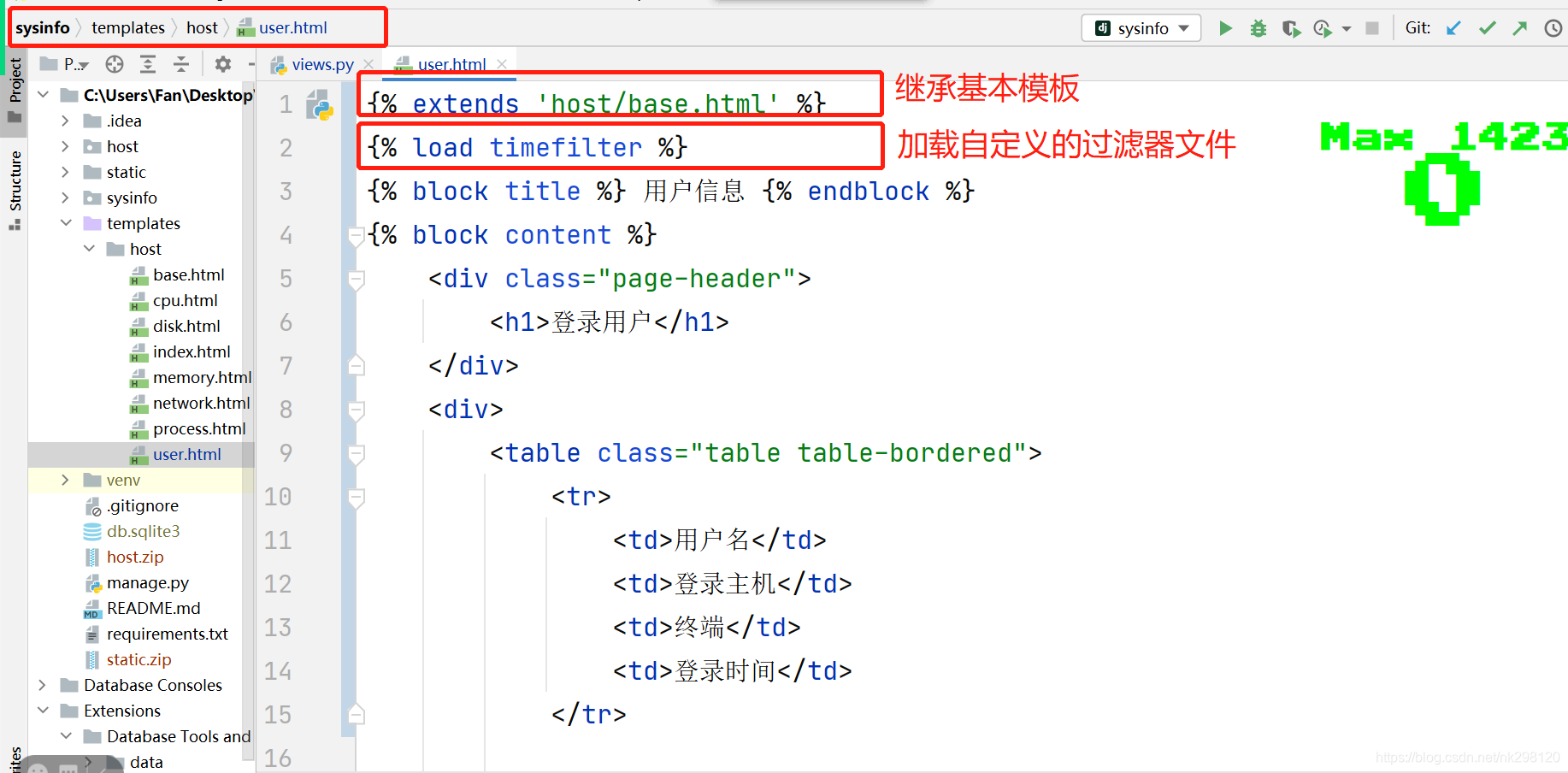文章目录
一、用户信息展示页面
1.自定义过滤器
from django import template
from datetime import datetime
register = template.Library()
@register.filter(name='timefmt')
def timefmt(value):
"""将时间戳转换成datetime类型的时间"""
return datetime.fromtimestamp(value)
官方文档:https://docs.djangoproject.com/zh-hans/3.1/howto/custom-template-tags/.
2.视图函数
def user(request):
users = psutil.users()
return render(request, 'host/user.html', locals())
3.html文件编写
{
% extends 'host/base.html' %}
{
% load timefilter %}
{
% block title %} 用户信息 {
% endblock %}
{
% block content %}
<div class="page-header">
<h1>登录用户</h1>
</div>
<div>
<table class="table table-bordered">
<tr>
<td>用户名</td>
<td>登录主机</td>
<td>终端</td>
<td>登录时间</td>
</tr>
{
% for user in users %}
<tr>
<td>{
{
user.name }}</td>
<td>{
{
user.terminal }}</td>
<td>{
{
user.host }}</td>
<td>{
{
user.started | timefmt }}</td>
</tr>
{
% endfor %}
</table>
</div>
{
% endblock %}



4.效果展示

二、CPU信息的图形化展示
1.编辑相关html文件
templates/host/cpu-header.html:
<div class="page-header">
<a {
% if not chart %}id="display"{
% endif %} href="/cpu/">CPU 信息</a>
<a {
% if chart == 'line' %}id="display"{
% endif %} href="/cpu/line/">CPU
折线图</a>
<a {
% if chart == 'pie' %}id="display"{
% endif %} href="/cpu/pie/">CPU 饼图</a>
</div>
templates/host/cpu-line.html:
{
% extends 'host/base.html' %}
{
% load timefilter %}
{
% block title %} cpu信息 {
% endblock %}
{
% block content %}
{
% include 'host/cpu-header.html' %}
<div>
<div id="main" style="width: 80%;height:400px;"></div>
</div>
<script type="text/javascript">
// 基于准备好的dom,初始化echarts实例
var myChart = echarts.init(document.getElementById('main'));
option = {
xAxis: {
type: 'category',
data: ['Mon', 'Tue', 'Wed', 'Thu', 'Fri', 'Sat', 'Sun']
},
yAxis: {
type: 'value'
},
series: [{
data: [820, 932, 901, 934, 1290, 1330, 1320],
type: 'line',
smooth: true
}]
};
// 使用刚指定的配置项和数据显示图表。
myChart.setOption(option);
</script>
{
% endblock %}
templates/host/cpu-pie.html:
{
% extends 'host/base.html' %}
{
% load timefilter %}
{
% block title %} cpu信息 {
% endblock %}
{
% block content %}
{
% include 'host/cpu-header.html' %}
<div>
<div id="main" style="width: 80%;height:400px;"></div>
</div>
<script type="text/javascript">
// 基于准备好的dom,初始化echarts实例
var myChart = echarts.init(document.getElementById('main'));
option = {
tooltip: {
trigger: 'item'
},
legend: {
top: '5%',
left: 'center'
},
series: [
{
name: 'CPU占用百分比分类',
type: 'pie',
radius: ['40%', '70%'],
avoidLabelOverlap: false,
itemStyle: {
borderRadius: 10,
borderColor: '#fff',
borderWidth: 2
},
label: {
show: false,
position: 'center'
},
emphasis: {
label: {
show: true,
fontSize: '40',
fontWeight: 'bold'
}
},
labelLine: {
show: false
},
data: [
{
value: {
{
cpu_time_percent.user }}, name: '用户'},
{
value: {
{
cpu_time_percent.system }}, name: '系统'},
{
value: {
{
cpu_time_percent.idle }}, name: '空闲'},
]
}
]
};
// 使用刚指定的配置项和数据显示图表。
myChart.setOption(option);
</script>
{
% endblock %}
templates/host/cpu.html:
{
% extends 'host/base.html' %}
{
% load timefilter %}
{
% block title %} cpu信息 {
% endblock %}
{
% block content %}
{
% include 'host/cpu-header.html' %}
<div>
<div id="cpu_info">
<table class="table table-bordered">
<tr>
<td>物理 CPU 核心数</td>
<td>{
{
physical_core_num }}</td>
</tr>
<tr>
<td>逻辑 CPU 核心数</td>
<td>{
{
logical_core_num }}</td>
</tr>
<tr>
<td>最近 1 分钟平均负载</td>
<td>{
{
load_avg.0 }}</td>
</tr>
<tr>
<td>最近 5 分钟平均负载</td>
<td>{
{
load_avg.1 }}</td>
</tr>
<tr>
<td>最近 15 分钟平均负载</td>
<td>{
{
load_avg.2 }}</td>
</tr>
<tr>
<td>用户</td>
<td>{
{
cpu_time_percent.user }} %</td>
</tr>
<tr>
<td>系统</td>
<td>{
{
cpu_time_percent.system }} %</td>
</tr>
<tr>
<td>空闲</td>
<td>{
{
cpu_time_percent.idle }} %</td>
</tr>
{
% if cpu_time_percent.nice %}
<tr>
<td>nice</td>
<td>{
{
cpu_time_percent.nice }} %</td>
</tr>
{
% endif %}
{
% if cpu_time_percent.iowait %}
<tr>
<td>iowait</td>
<td>{
{
cpu_time_percent.iowait }} %</td>
</tr>
{
% endif %}
{
% if else_percent %}
<tr>
<td>其他</td>
<td>{
{
else_percent }} %</td>
</tr>
{
% endif %}
{
% if cpu_freq %}
<tr>
<td>正在运行频率</td>
<td>{
{
cpu_freq.current | cpu_val_fmt }} GHz</td>
</tr>
<tr>
<td>最低运行频率</td>
<td>{
{
cpu_freq.min | cpu_val_fmt }} GHz</td>
</tr>
<tr>
<td>最高运行频率</td>
<td>{
{
cpu_freq.max | cpu_val_fmt }} GHz</td>
</tr>
{
% endif %}
</table>
</div>
</div>
{
% endblock %}
2.自定义过滤器
host/templatetags/timefilter.py:
@register.filter(name='cpu_val_fmt')
def cpu_val_fmt(value):
return round(value/1000, 2)
3.设置路由和视图函数
host/urls.py:
path('', index, name='index'),
path('user/', user, name='user'),
path('cpu/', cpu, name='cpu'),
path('cpu/<str:chart>/', cpu, name='cpu'), %新增
path('memory/', memory, name='memory'),
path('disk/', disk, name='disk'),
path('network/', network, name='network'),
host/views.py:
def cpu(request, chart=None):
logical_core_num = psutil.cpu_count() #
physical_core_num = psutil.cpu_count(logical=False)
try:
load_avg = os.getloadavg()
except Exception as e:
load_avg = ['', '', '']
cpu_time_percent = psutil.cpu_times_percent()
else_percent = 0.0
for i in range(3, 5):
else_percent += cpu_time_percent[i]
try:
cpu_freq = psutil.cpu_freq()
except AttributeError:
cpu_freq = None
if chart == 'line':
return render(request, 'host/cpu-line.html', locals())
elif chart == 'pie':
return render(request, 'host/cpu-pie.html', locals())
return render(request, 'host/cpu.html', locals())
4.基于echarts的图形页面展示
图形页面展示时需要从数据库表中读取信息(这些信息需要使用定时任务来获取,下节会写关于定时任务的相关内容,现在我们先来实现页面的展示),因此需要更改数据库模型
修改数据库模型及基模板:
host/models.py:
from django.db import models
# Create your models here.
class UserCpuPercent(models.Model):
create_time = models.DateTimeField(auto_now_add=True, verbose_name="扫描时间")
user_percent = models.FloatField(verbose_name="用户CPU占用百分比")
注意:更改数据库模型后要记得生成迁移脚本并执行
templates/host/base.html:
<link rel="stylesheet" type="text/css" href="/static/css/bootstrap.css">
<link rel="stylesheet" type="text/css" href="/static/css/my-style.css">
<script src="/static/js/jquery-3.1.1.min.js"></script>
<script src="https://lib.baomitu.com/echarts/5.0.2/echarts.min.js"></script> %新增
{
% endblock head %}
</head>
<body>

这里展示的折线图并不包含主机的真实信息,只是一个图形界面(因为我们没有设置定时任务来获取主机的相关信息):

饼状图反映的是真实的主机信息:
